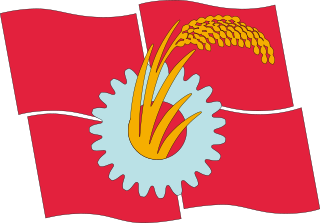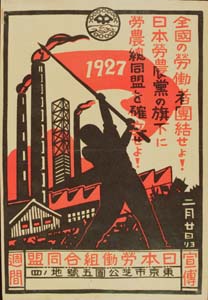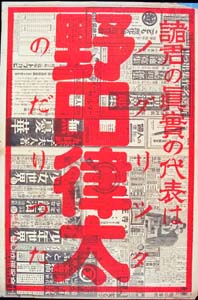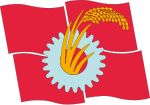Related Research Articles

The Japanese Communist Party is a communist party in Japan. Founded in 1922, it is the oldest political party in the country. It has 250,000 members as of 2024, making it one of the largest non-governing communist parties in the world. The party is chaired by Tomoko Tamura, who replaced longtime leader Kazuo Shii in January 2024.

Shimbun Akahata is the daily newspaper of the Japanese Communist Party (JCP) in the form of a national newspaper. It was founded in 1928 and currently has both daily and weekly editions.

The Japan Labour-Farmer Party was a socialist political party in Japan between December 1926 and December 1928. During its existence, it occupied a centrist position in the divided socialist movement.
The General Federation of Japanese Peasant Unions was a farmers' organization in Japan. The organization was formed on March 7, 1927. It was an initiative of the Social Democratic Party to gain ground amongst the peasantry. The organization functioned as the rural counterpart of the Sodomei trade union centre.

The Japan Labour Union League was a trade union centre in Japan. It was founded in December 1926, following the split in the Social Democratic Party as the leaders of the dissident Japan Labour-Farmer Party were expelled from the social-democratic Japan Federation of Labour (Sodomei) trade union centre. The Japan Labour Union League functioned as the trade union wing of the Japan Labour-Farmer Party, and had around 5,000-6,000 members.

The Labour-Farmer Party was a political party in the Empire of Japan. It represented the left-wing sector of the legal proletarian movement at the time. Oyama Ikuo was the chairman of the party. At the time the party was banned by the government in 1928, it was estimated to have around 90,000 members in 131 local organizations. The party was supported by the Hyōgikai trade union federation and the Japan Peasant Union.
The Proletarian Masses Party was a short-lived political party in Japan. It was founded on July 22, 1928 by the Rōnō faction. Suzuki Mosaburō became the general secretary of the party. Yamakawa and Sakai Toshihiko functioned as 'elder' advisors in the party. Other prominent founders of the party were Kuroda, Inamura Junzo and Okada.
The Japan Farmers Party was a political party in Japan between 1926 and 1928. It represented a rightist tendency amongst the proletarian parties in the country at the time. The party had a nationalist orientation.
The Social Democratic Party was a political party in Japan between 1926 and 1932. Amongst the three main proletarian parties in Japan at the time, the Social Democratic Party occupied a rightist position.
The National Democratic Party was a political party in Japan, led by Miyazaki Ryusuke. Miyazaki broke away from the Social Democratic Party in 1929, after having drifted towards conservative positions. The party contested the 1930 elections, with Miyzaki unsuccessfully running in the Fourth district. After the 1930 election the party merged with the Japan Masses Party, the Tokyo Proletarian Party and ten local parties, forming the National Masses Party.
The proletarian parties were a group of left-wing political parties in Japan. Several proletarian parties were launched after enactment of the Universal Manhood Suffrage Act in 1925.
Nihon Rōdō Kumiai Hyōgikai was a trade union centre in Japan which has been operational since 1920.
The Young Communist League of Japan was a youth organization in Japan and the youth wing of the Japanese Communist Party. The Young Communist League was founded in the summer of 1925, by communist activists from the Hyōgikai youth division and the All-Japan Student Social Science Federation. The Young Communist League was led by Kitaura.

Ritsuta Noda was a Japanese trade unionist and politician. Noda served as the chairman of the pro-communist national trade union centre Hyōgikai.
The Farmer-Labour Party was a short-lived socialist political party in Japan. The party was the first of the proletarian parties that emerged in the country after the enactment of the Universal Manhood Suffrage Act of 1925. The party was banned by the Japanese government just a few hours after its foundation.
Fukumoto Kazuo was a Japanese Marxist and one of the most important theoreticians of the Japanese Communist Party during the 1920s.
Shigeo Kamiyama was a Japanese communist. He was born in 1905 in Shimonoseki. In 1928, he joined the Japanese Communist Party.
Relations between Japanese revolutionaries, the Comintern and the Soviet Union existed from the 1920s until the collapse of the Soviet Union in 1991.

Masanosuke Watanabe was a member of the Japanese Communist Party. He was born in 1899 in Ichikawa, Chiba Prefecture. He was the son of a tatami mat maker. After graduating primary school in 1912, he went to Tokyo to work in a wine shop. In 1917, he worked in a celluloid factory in Kamedo section of Tokyo. He organized the National Celluloid Workers Union in Tokyo in 1919. He joined the Japanese Communist Party soon after its establishment in 1922. In March 1927, he went to Moscow to represent the JCP at the Comintern, and the eighth enlarged plenum of the ECCI. That same year, Watanabe returned to Japan and took over the leadership of the party. In March 1928, he was elected chairman of the JCP central committee. During Watanabe's lifetime, he married Tanno Setsu, a labour activist, and member of the Communist Party.

Eighteen Years in Prison is a Japanese autobiographical book by Kyuichi Tokuda and Yoshio Shiga.
References
- ↑ Beckmann, George M., and Genji Okubo. The Japanese Communist Party 1922–1945 . Stanford, Calif: Stanford University Press, 1969. pp. 34, 49
- ↑ Scalapino 1967, pp. 8, 14–15.
- ↑ Scalapino 1967, pp. 17.
- 1 2 3 4 Beckmann, George M., and Genji Okubo. The Japanese Communist Party 1922–1945 . Stanford, Calif: Stanford University Press, 1969. pp. 32–35
- 1 2 Smith, Henry DeWitt. Japan's First Student Radicals . Cambridge, Massachusetts: Harvard University Press, 1972. p. 97
- ↑ Beckmann, George M., and Genji Okubo. The Japanese Communist Party 1922–1945 . Stanford, Calif: Stanford University Press, 1969. pp. 39–40
